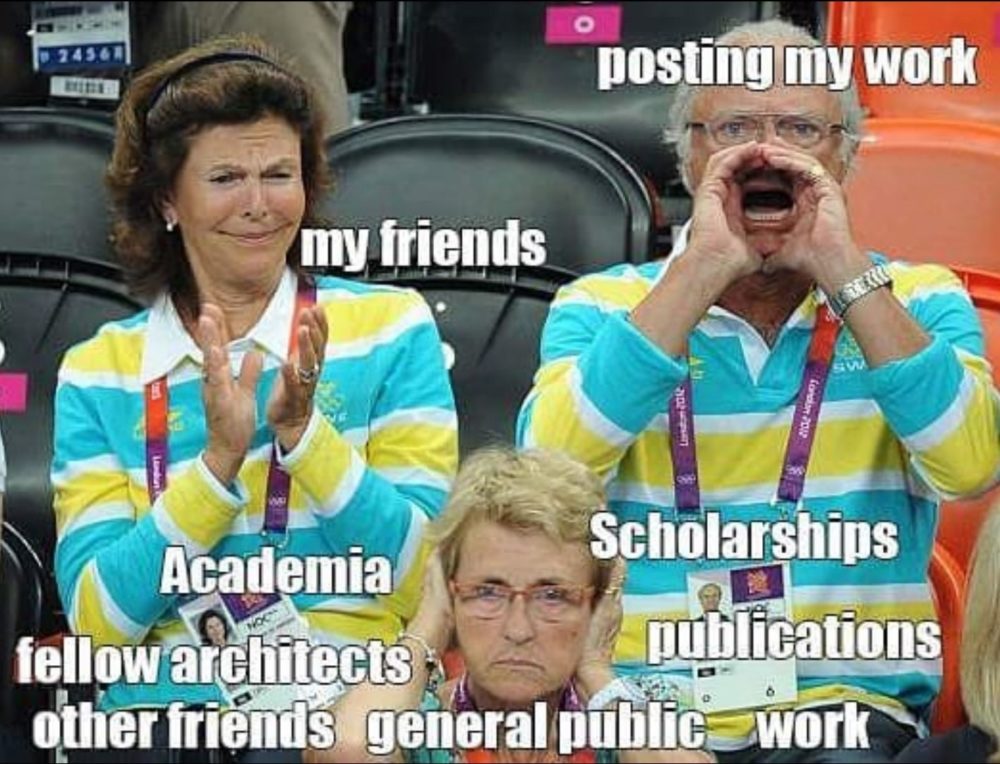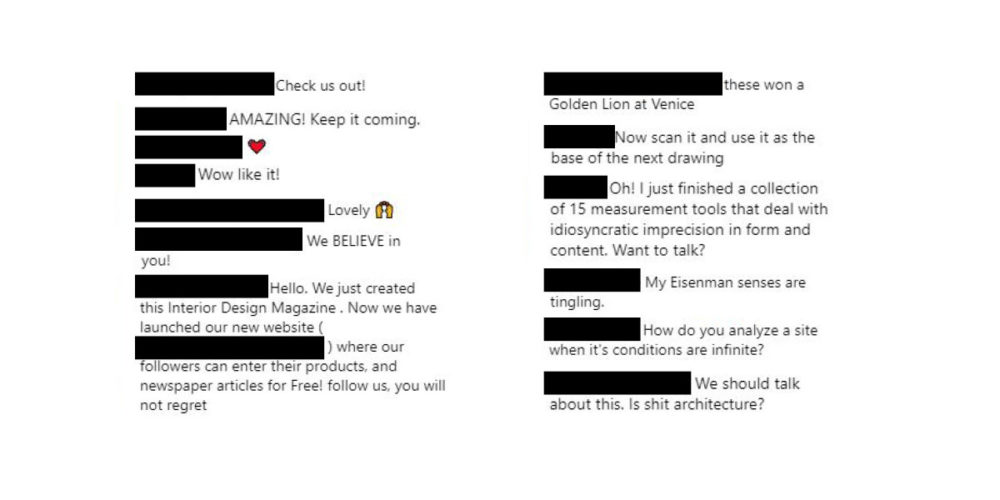Like never before, designers are confronted with a mounting pressure to get more eyes on their work. Today, this is accomplished mainly through social media, in addition to a renewed interest in the rogue exhibition and curatorial project. For instance, the One Night Stand curatorial project in Los Angeles, The Sideshow at the Chicago Architecture Biennale of 2017, or Team B of Cincinnati’s Rejected show. In addition see articles like "Why Instagram Should Be a Part of Every Architect's Design Process." ArchDaily. May 14, 2017. https://www.archdaily.com/871238/why-instagram-should-be-a-part-of-every-architects-design-process. Equipped with a multitude of platforms, hashtags, and accounts that repost work, designers have the seemingly simple task to develop a community of followers. Yet sharing images is rife with empty feedback. “Great Photo!” someone comments on a rendering. “Excellent use of color!” another account delightfully adds, regardless of the color. Reflecting on this result makes one feel like John Malkovich sitting at a dining table across from Malkovich, being waited on by Malkovich, and finding only Malkovich on the menu. Inside of this existential echo chamber filled with people and bots indistinguishable - who - or what - is really listening?
The platform of choice for the young architect is Instagram. The photo sharing social media app has 800 million users and counting, and it is teeming with a general public eager for images regardless of disciplinary content - an appealing place with fertile ground for designers. Architecture on Instagram is a vaguely democratic society where relevance is gained by those who connect with and are legitimated by the highest number of followers. This sharing can be described as a systematic dissemination of a particular style, wherein the architectural project itself is pumped out into the universe.See the profiles of iHeartBlob (@iheartblob), Bryan Cantley (@bcantl3y), Andrew Kovacs (@archiveofaffinities,) Laida Aguirre (@stock____), Hans Koesters (@hans_koesters), Harrison Steinbuch (@_harrison.steinbuch), Tony Gonzalez (@tonygonzalez_net), Eric Lawler (@_________spam), or the entire Instagram machine of the University of Michigan Taubman College. This is among a host of students and colleagues whose studio work is filtered through this medium and are too numerous to name here. For some, this eventually feels one-sided and self-aggrandizing. There is no ‘I’ve arrived’ moment when it comes to growing your following, and one feels despondent when it is revealed, by default, that all architecture account followings are easily dwarfed by SoundCloud rappers and pseudo-fashionistas called ‘influencers.’ These influencers masquerade as experts only to become the television commercial of the future, whose true intentions are revealed by the words “Link in Bio.”See Theresa M. Senft in her chapter called ‘Microcelebrity and the Branded Self’ when she says “stars don’t accumulate capital because they get attention; they accumulate capital because they have managed to turn themselves from citizens to corporations, vis-à-vis the proprietary organization of the attention of others.” Hartley, John, Jean Burgess, and Axel Bruns. A Companion to New Media Dynamics. Wiley-Blackwell, 2015. There is a growing anxiety that architecture will be completely subsumed by these influencers and exist only as backdrops to drive business and commerce.See Bereznak, Alyssa. "What Happens When a Space Is Designed Specifically for Instagram Likes?" The Ringer. August 09, 2017. //theringer.com/tech/2017/8/9/16110424/instagram-playground-social-media.
How exactly do we find a discursive environment on a platform most architects use only for advertising themselves?See Lange, Alexandra. "Opinion: Alexandra Lange on How Architects Should Use Social Media." Dezeen. February 16, 2016. //dezeen.com/2014/01/07/opinion-alexandra-lange-on-how-architects-should-use-social-media/. Without writing a history - architecture research is already available in multiple platforms; from books, magazines, and lectures to newer media like podcasts or SportsCenter-style breakdowns of important lectures.See SCI-Arc Channel’s Clip Joint Duel + Duet: Slavoj Zizek and Graham Harman or the forthcoming production of a similar work on the lecture of Gregory Crewdson. In these mediums there is a Dwell and a Log or even a 99% Invisible and a Night White Skies. What differentiates Instagram as a medium from others is the rapidity of the image, limitation of words in favor of images, and finally the ability for mass individual input. Since slower mediums and the opportunity for longer writings exist, the first two aren’t fundamentally threatening. It is instead the third item that opens ominous territory.
Architecture and the arts in general have a well-documented relationship between avant-garde and pop. In its cycling through various media, complex themes of the avant-garde have historically influenced the larger, but less risky world of popular culture. But, like never before, individuals are able to directly influence - and truly participate in - the evaluation of culture itself. Platforms like SoundCloud, YouTube, and Instagram take the input of individuals and turn it directly into the rubric that defines legitimation. This unprecedented decentralization is a disruption to its normally linear dissemination, vis-a-vis record labels, production studios, or textbooks.
This signals a major shift in the way the institution projects legitimation. In addition, architectural content on Instagram exists in this tangential, confusing, and easily manipulated model of consensus. For an educator, the broad takeaway is that social media is a surging element in the wide array of ways in which ethics are taught through behavior modeling.For more on the design studio and student experience with Instagram, see the interview with Michael Osman in POOL titled “Family Values” "Osman_Family Values." POOL. //pool-la.com/osman-family-values. But for those seeking potential avenues in the curation, publication, and critical realms, considering social media as an apparatus of consensus is a catch-22, where the number of likes and followers is both the decider of relevance yet completely meaningless.
As a result of this decentralization, discourse is flooded with bloviated imagery, making it difficult to judge which ideas are actually interesting and innovative.See Matt Shaw’s "Thanks to the Internet, Does Architecture Have a Crisis of Ideas?" The Architects Newspaper. June 20, 2017. Accessed July 30, 2017. //archpaper.com/2017/06/architecture-crisis-ideas/. When Instagram projects are chosen for gallery walls, or published on a curated feed, it is important to to disavow that superfluous imagery. The rogue exhibition accounts for this by limiting the viewing time, where the event itself becomes an apparatus of productive FoMO.FoMO stands for “Fear of Missing Out,” a slang term that describes the anxiety felt when one finds out that an exciting or interesting event is currently happening elsewhere. It is often induced by posts seen through social media. This anxiety is more palpable to a millennial culture more interested in sharing experiences than owning things. This curatorial tool empowers - for better or worse - the rogue exhibitions previously discussed, successfully amplifying One Night Stand in Los Angeles while negatively augmenting the myopic discordance of architecture, architectural, and Architecture at the A+D Architecture and Design Museum. In this framework, architecture and art will rely heavily on the ability of curators to outperform the algorithmic suggestions of the Semantic Web. The Semantic Web is the era of the internet defined by automated recommendations based on user preferences. It is what brings you “Suggested Friends” from Facebook, “Top Picks for You” from Amazon, and the presumptuous “87% match” from Netflix. Any architectural curation with claims of disciplinarity cannot fall into line with those automated suggestions (unless, of course, it is presented as such) due to the curatorial dependence on a concocted consensus. As Barthes describes authorship in a context outside of the individual, so a curators choices wouldn’t belong to architecture but to automation masquerading as expertise.
The power of social media should give practitioners and educators hope for the new prospects it can bring to architecture. It is now possible to have discussions across borders and long distances, providing new opportunities and insights. It is beneficial to tag other accounts and show aspects of the discipline to a wider audience.How can we define the discipline without constantly negotiating the border between its practitioners and the public? But be suspicious of curators or institutions posturing to gain followers resulting from their curatorial choices. In doing so, the development of conversations in architecture would no longer be curated for the crowds, but by the crowds themselves.
Who or what is listening? I am reminded of a scene from the 90’s film White Men Can’t Jump when Sidney Deane (Wesley Snipes) tells Billy Hoyle (Woody Harrelson) that there is a difference between hearing Hendrix and merely listening to Hendrix when he says “that's what the problem is, y’all listen to it... you’re supposed to hear it.” Sidney claims that listening is easy, but a good listener is one who hears a conversation attached to a cultural constituency. So be patient with likes, shares, and followers, have a little fun, and strive to create content in which other architects can read and react to architectural problems presented as such. And perhaps most importantly; be a good listener.



